And a love story for the ages that’s been pleasingly resurrected.
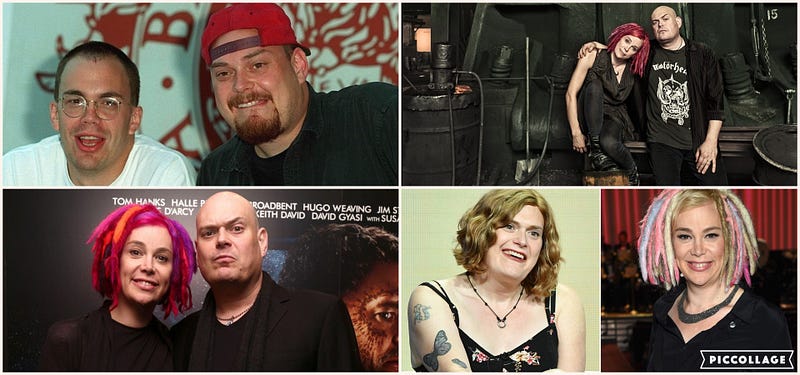
The four film reviews that follow were written by a Matrix obsessive who reveres the whole ethos, spirit and existential thinking of the original film of 22 years ago and the trilogy, and now very pleasingly quadrilogy of films that it spawned. I hold the original film in 1999 very dearly to my crazily warped mind and it’s been a long 18 years in The Matrix for the release of the fourth instalment and one that pleased me greatly and one that continued the flame and the central theme of the entire cinematic series: love. For this is a love story at heart, for all it’s bizarre tales of dream masters and architects and your mind not bending spoons whilst your mind tries to catch up on why and who and where? And when?
And why?
The Matrix as a cinematic series is a love story at heart and a love story I too love, as well as obsess over, take too literally, perhaps take too seriously even but when you’ve dropped your own particular red pill, perhaps there’s no other way of viewing these surreal pieces of escapist cinema.
As always, my reviews come spoiler free but perhaps a heaped spoonful more of love and admiration than I normally bestow upon my favourite films. My reviews of the original trilogy of films was originally written in 2013 and previously posted on my film blog but appear here restored with a lot more digital love than I had to give 9 years ago. The Matrix Resurrections has been reviewed as a “reaction piece” and written straight after my first viewing late yesterday, 23rd December 2021.
And as always, I hope you enjoy my take on these cinematic gems

“You are the one, Neo”.
What follows are my three favourite scenes from each film of The Matrix Trilogy briefly dissected each a little differently each time, each hopefully pleasing The Matrix purists out there and even more hopefully, confusing those of you who haven’t yet seen these majestic films! Each one is majestic in it’s own way, the first and original film is damn near perfection in every scene and a firm personal favourite that captures my imagination every time I watch and never grows tiresome or older with time. A sure fire timeless classic if you will. The second film The Matrix Reloaded in the trilogy falls somewhat short of it’s predecessor, with exposition heavy character development and a some might say deliberate style of story telling that can confuse and disengage an audience. It still remains a brilliant if flawed follow up for some virtuoso performances and action sequences that still remain fresh and joyous ten years after release. The third instalment The Matrix Revolutions comes and goes in a blur of CGI excess that even for The Matrix is overblown and often absurd and my least favourite of the original trilogy.
I love the original (and best) Matrix film to almost obsessive levels. It resonates with me on theological and philosophical levels of the nature of our lives, our reality as we perceive it, the nature of dreams and indeed the way all of these and many more aspects are manipulated in our daily lives. Hang with me here! Conspiracy theories abound on how our lives are shaped by others, by television, film and mass media and this film explores those so called theories thoroughly and majestically so at times. I personally swallowed the red pill a long time ago however, as with the vast majority of the population I too am constantly distracted by that woman in the red dress!
“Free you mind” is a mantra from the first film, a constant action demanding you to look at things, objects, events and realities in a different way. But very importantly for me, it also challenges you to look at these same differing aspects with your heart. For The Matrix series of films themselves are a love story at heart and of unbounded love between Trinity and Neo. It’s not a motif for the film, more a theme than runs through the series and more of which later. On a purely theological point before we continue, “The One” is a huge theme throughout the trilogy and rightly so. However it leaves me a little uncomfortable as, on a theological level, there is an argument to be made that this representation of a God or Deity allows us to relinquish power and control over our lives to one person and to their control. The argument again could be made that this contradicts the constant theme of breaking out from this regimented control in life that the trilogy advocates. Whilst it leaves me uncomfortable, I’ll leave the theological discussion for erstwhile people far more qualified than I.
And we’re all part of a universal whole or “One” in my ever so humble opinion anyway, spinning on a rock through the universal infinity.
Where was I? Oh yes, The Matrix!
Whilst the original film is an undoubted all time classic, the second a little behind and the third limps across the finish line with far too much CGI, the trilogy draws on a wealth of acting talent that have either cemented a place in acting folklore or been catapulted into cinema history due to their impact in the trilogy. Keanu Reeves as “Neo”, Carrie-Anne Moss as “Trinity” and Laurence Fishburne as “Morpheus” are the marquee names that carry the trilogy, however they are ably assisted by superb performances from Joe Pantoliano as “Cypher”, Gloria Foster as “The Oracle” (plus Mary Alice as The Oracle in Matrix Revolutions), Hugo Weaving as “Agent Smith”, Monica Bellucci as “Persephone”, Collin Chou as “Seraph”, Jada Pinkett Smith as “Niobe” and Lambert Wilson as “Merovingian”. These are but the stand out performers amongst a huge cast across the trilogy on the screen, but behind the scenes and indeed screen, The Wachowski’s called upon regular collaborators Bill Pope (Director of Photography), Zach Staenberg (Editing), Don Davis (original music), Owen Paterson (Production Designer) and Kym Barrett (Costume Designer) amongst many many others.
The films themselves are eminently quotable and I’ve included more quotes in the nine dissected scenes than I normally do in my other film appraisals purely to reflect this and also give a flavour for the scene itself and it’s often bizarre, contradictory nature. I found the films as a whole a voyage of self discovery in many ways, but that’s probably the film geek/idealist in me speaking, but from a Director(s) perspective, they did indeed discover new ways of working, producing and directing these films, with some saying (OK, me!) that they reinvented many aspects of cinema. Bullet time cameras for example are taken as a given today in 2013, but were revolutionary and revelatory in 1999. The camera moves and edits between the ferocious combat scenes again revolutionised cinema to a degree, as did their story telling. Becoming more clumsy and drawn out as the trilogy progresses is an argument, however the actual original premise and story itself urges it’s audiences to keep up, pay attention, think and reflect, as well as enjoying a spectacular ride.
The trilogy of Matrix films have spawned computer game spin offs (oh the irony!), spoof send ups and a host of other related cinematic nods, but it’s the branching out from cinema and into the mainstream of thought, of consciousness and awareness that seals my personal approval. There is a definite act of defiance running through the series (as it does through all Wachowski films) of not settling for the reality we are presented with, of challenging the status quo and questioning what is reality and more importantly of asking you to follow your heart, make your own decisions even if they are contrary to so called popular belief.
The film’s have certainly had an influence on The Wachowski’s other films (see V for Vendetta and Cloud Atlas), plus their ideas and beliefs have influenced the likes of Duncan Jones (Source Code) and Christopher Nolan (Inception). There are numerous constant themes throughout the films, ideological, theological and philosophical viewpoints can all be made, but many are personal and personal taste too. There’s no doubting on a purely base level that the films are a love story, of compassion and a better way for human beings to interact with each other and to break out of regulated thought and patterns of thought. On a much deeper level, it challenges you to reflect on what is real, what can be real and tangible when in fact these “real” objects are made of ions or atoms that have no solidity and so can’t actually be real at all but merely “electrical signals” passing through to our brains. To paraphrase Morpheus: of a world played out before you to blind you from the real truth, thus preventing you from seeking this truth, of a better, more enlightened world of human beings.
These films intrigue me almost like no other, which you may have gathered by now. Within the following nine dissected scenes I’ve probably (conservatively) provided only 5–10% of the entire six plus hours of the trilogy, so I hope I haven’t spoilt this any further than that. I’ve split the dissections per film and only intend these as a taster for the films themselves, which suffice to say I heartily and highly recommend whether you’ve seen them already or not.
On with the show!
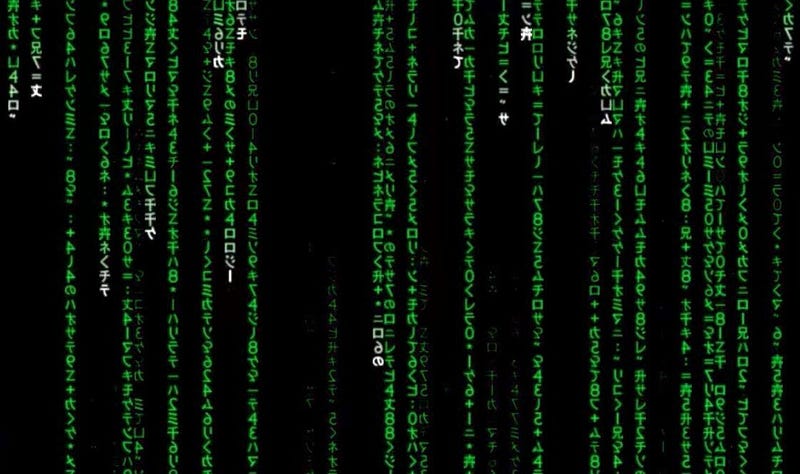
Amidst what you will soon be familiar with as Matrix Code, of scrolling green text and numbers scrolling down a computer screen (otherwise known as “digital rain”) we cut to another computer screen, of different text, and a dial tone. The narrated conversation between two unseen characters that follows is fractured, yet tender at times, but the tenderness and concern is broken with a dismissive “We’re gonna kill him, you understand that?” from the unseen male voice. “Morpheus believes he is the One” comes the straight forward unemotional reply from the still unseen female voice. “You sure this line is clean?” and a worried “I better go” are this unseen female’s final words as we zoom fade through yet more Matrix code and brilliantly twisting through a torchlight into a pitch black room, only lit by the torchlights of several police officers making their way towards Room 303.
You will also soon become familiar with the twisting, metallic sound effect that has become so synonymous with this trilogy of films, as we wind our way through The Matrix repeatedly. Often accompanying the “jump” if you will, but certainly accompanying the Matrix shifts. Anyway, back to Room 303.
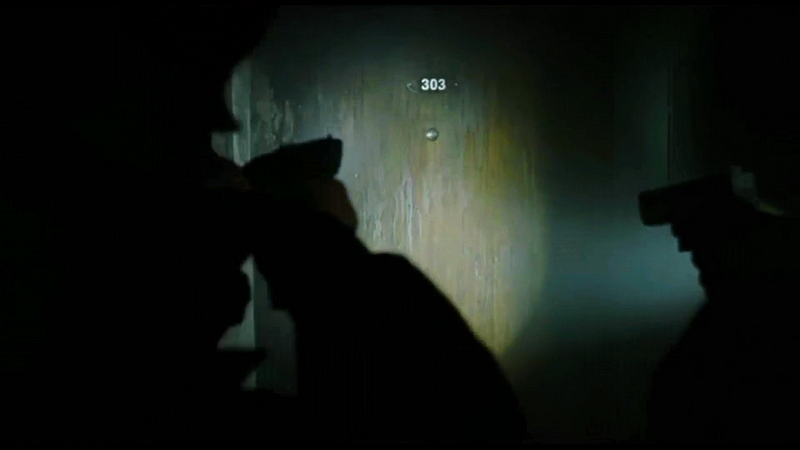
Still in pitch black darkness, the police officers kick the door down to apprehend “Trinity” (Carrie-Ann Moss), their torch lights now illuminating a sparse room. With a slow fade and camera move to face Trinity, she slowly raises her hands to surrender. Quick cutting sees the arrival of “Agent Smith” (Hugo Weaving), smartly dressed, eager of tone and deliberate, purposeful pronouncements introduce us to the first of many stunning acting scenes from Weaving. With his deliberate, robotic style of speaking he dismisses the local police of their assertion that Trinity’s arrest is imminent with a portentous “No Lieutenant. Your men are already dead” and strides into the building.

Back inside the building, we cut to Trinity, hands now on head, facing the wall. Interesting (key?) to note her shadow cast on the wall beside her which is followed by a genius of a camera angle, cutting as we do to between her raised arm (which captures the approaching police officer) and just one of her eyes, fixed and awaiting the advance. What follows is breath taking and the first use of what became known as “bullet time” motion captured action. Frozen time/dead time/time slice/flow motion are all describing the same unique camera motion and capture: Bullet Time. With a spinning high Kung Fu kick in Bullet Time a prelude to running up an adjoining wall to avoid the officer’s bullets, all officers are dead in quite literally bullet time.
Traced and tracked by Agents assisting Agent Smith what follows is a breathless scene using bullet time techniques and traditional moving, spinning cameras as Trinity is pursued across the city’s rooftops. Sprinting and jumping to avoid capture, The Matrix itself is further evidenced as only Trinity and the pursuing Agent can leap the death defying longer leaps necessary across huge chasms in the city landscape than the also pursuing police officers.
Now with just the one Agent in pursuit but nowhere seemingly to escape, Trinity spots a tiny window and sprints headlong toward to it. Captured brilliantly by moving cameras, slow motion cameras and involving an obscured camera shot too (which seem on reflection to me to be a metaphor for The Matrix itself), the corkscrew leap through the window is brilliantly captured also, through the tumbling fall down the staircase and the guns drawn focussed on the window finale’.
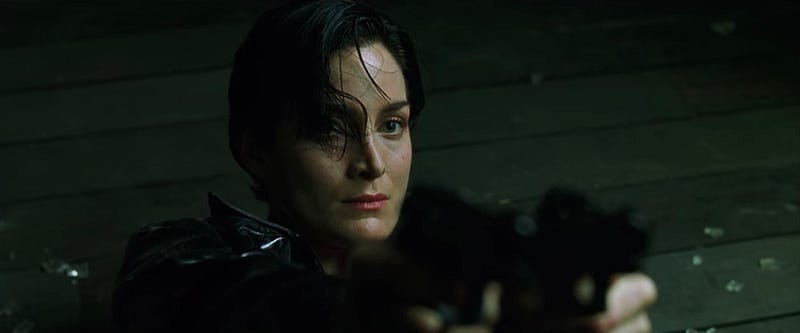
Still needing an escape, her only hope is a nearby telephone booth which will transport Trinity out of The Matrix. Barring her way is Agent Smith who has tracked and anticipated her next move and approaches fast inside a large truck. The booth destroyed but no body evident, Agent Smith is joined by two of his fellow Agents who confirm the name of their next target, “The name is Neo”. Brilliantly shot again as we twist between the rubble and through the remaining telephone, and amidst the twisting metallic musical theme and Matrix computer code we arrive at another computer screen, beeping and “Searching”.

Before the introduction of the film and indeed the trilogy of films star, it’s very interesting to note the first website or notification shown on the searching computer screen, as the camera slowly fades to reveal a quickly scrolling “Morpheus eludes police at Heathrow Airport” before the introduction of “Neo” (Keanu Reeves) or “Thomas Anderson” as we should be calling him at this stage of the film. All will become clear very shortly into the film, however as he’s “The One” I’ll refer to him immediately as “Neo”. Played brilliantly (though not as flawlessly as some would have you believe, or as poorly as others have horribly sneered) Keanu Reeves infuses Neo immediately with a mix of tiredness, awake but not truly, or even asleep but never sure if he’s maybe dreaming of being awake? Insomnia is hinted at, as is his compulsion to talk online as an active member of the still embryonic Internet, and his passing interest in computer hacking. Following an overhead shot of a slumped at his desk Neo and his messy, litter strewn apartment, this cuts to a close up of Neo, still asleep, yet his computer screen implores him to:

Struggling to focus and wake up properly, Neo is also urged to “Follow the White Rabbit” before a tension breaking “Knock Knock, Neo” demonstrates both Neo’s hacking credentials and his ability to earn extra money from his illegal activities. Invited to a party and to join the buyers of his hacked discs Neo is hesitant, tired and aware he has to rise early for work, until he spots a tattoo of a white rabbit. Immediately his persona changes, from one of hesitancy to one of eagerness and wanting to join in. “Sure. I’ll go”.
Those opening nine minutes introduce the audience to both Trinity and Neo, the undoubted stars of the Trilogy of films as a whole. The next scene noted introduces us to The Matrix’s star performer and the key to unlocking minds, Morpheus.
Before the introduction however, The Wachowski’s excel in the build up to the scene, with a brilliant overhead shot of teaming rain pouring down the side of a darkened building, the sky illuminated by lightening amidst the rain shower, and a slowly moving camera shot of Trinity and Neo as they ascend a spiral staircase to their required floor. Interesting to note both the tiled floors (black and white chessboard design) and the saturated yellow but predominantly green colour and texture to the inside of the building. Deliberately drained in colour, it’s striking both in the contrast to the green computer code of The Matrix and perhaps also another perceived metaphor for life, drained and saturated of colour compared to The Matrix itself.
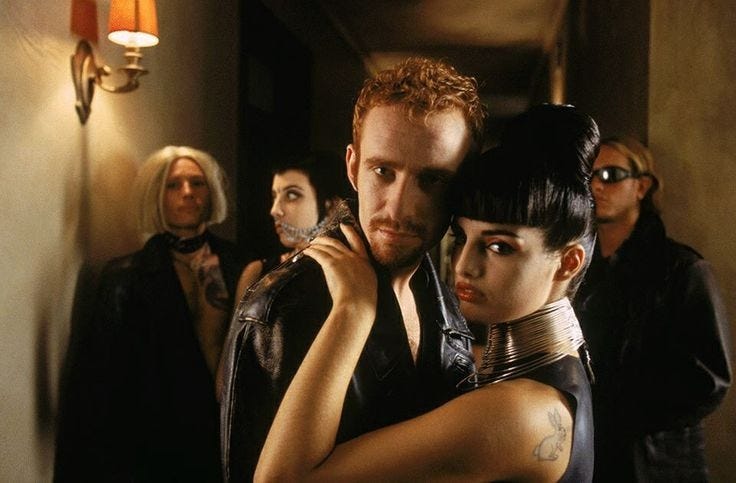
Neo is greeted by “Morpheus” (Laurence Fishburne) a still performance of calm, assuredness and damn near perfection. Fishburne is brilliant throughout the Trilogy but here his Morpheus character dominates the screen. Almost a narrator if you will, of the past, present and future worlds before Neo, his matter of fact interpretation of situations is evident immediately, as is his determination that his life/their lives are very real, very tangible, yet not in the way Neo believes. A simple scene ensues, often with only two cameras in a talking heads style with cutaways occasionally to let the scene breath. Yet this brief scene establishes both The Matrix itself and the dominant themes running throughout the film, of Alice in Wonderland, the nature of dreams, fate and the problems experienced within the “real” world, and of the starting of a performance from Fishburne that is near flawless.
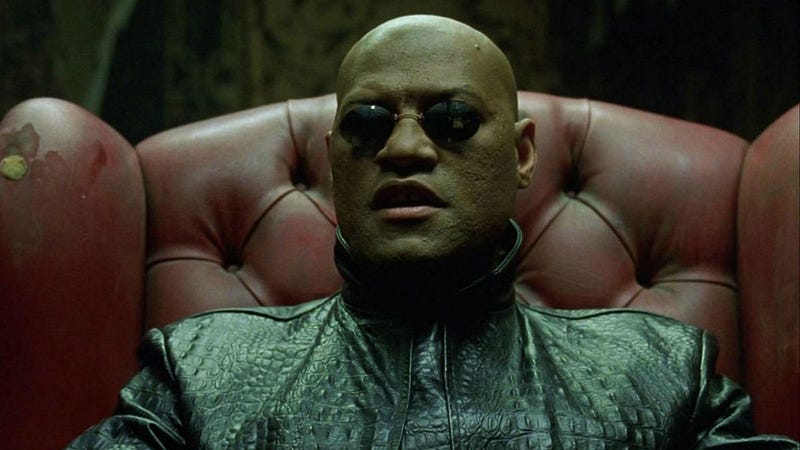
“It is an honour to meet you” offers Neo, to which Morpheus smiles in reply “No. The honour is mine”. Sitting in red leather chairs opposite each other, the short talking heads scene encompasses a bemused Neo, struggling to comprehend the world painted by Morpheus, who is sitting comfortably, twirling a silver case, his iconic sunglasses masking his eyes but definitely not his warm smile. Morpheus confirms:
“The Matrix is everywhere. It is all around us. Even now in this very room. You can see it when you look out of your window. Or when you turn on the television. You can feel it when you go to work, when you go to church, when you pay your taxes. It is the world that has been pulled over your eyes to blind you from the truth…..That you are a slave Neo. Like everyone else you have been born into bondage, born into a prison you cannot smell or taste or touch. A prison. For your mind”.
To experience The Matrix, Neo has a simple choice which is brilliantly captured and directed by The Wachowski’s. Cutting between a simple shot of a Blue and Red Pill we cut repeatedly a close up of Morpheus offering the pill(s), Neo reflected in his iconic sunglasses. Metaphor’s abound here, but I’ll let you decide for yourselves on this one. Taking the blue pill will result in Neo waking and returning to his normal world whereby the red pill will enable his full integration to The Matrix. “Take the Red Pill, you stay in wonderland, and I show you how deep the rabbit hole goes”.

Brief introductions follow, to “Cypher” (Joe Pantiliano), “Apoc” (Julian Arahanga) and “Switch” (Belinda McCrory) as Neo slowly transitions to The Matrix through twisting telephone lines and various machines all plugged into a central converting chair. Again, the Directors excel here, as Neo transitions we see melting mirrors and a slow twisting metallic skin covering Neo before he finally jumps into the matrix, accompanied by the now familiar twisting metallic Matrix sound effects.
The third and final scene to be dissected from the first film is the quintessential Matrix scene that made the original film. Our two heroes Neo and Trinity coming to the rescue of Morpheus, now under the spell of Agent Smith who is trying to break his mind and de-programme Morpheus in the upper floors of the building now entered by Neo and Trinity. This scene also showcased brilliantly the Director’s use of unbelievable slow motion captured action and of the director’s Bullet Time technology. Often imitated since, but never better than shown here. The scene commences with a slow motion shot of Neo’s booted feet and trench coat as he enters the building through a revolving door. He is seemingly alone and enters through the metal detectors and to the astonishment of the first Security Guard, displays a huge cache’ of hidden guns whereby the first use of bullet time is used and Neo disables this security guard. There follows a mix of bullet time, slow motion and overhead camera shots as Neo eliminates the majority of the guards on duty before being joined by Trinity who eliminates the last remaining guard as he calls for “back up”.
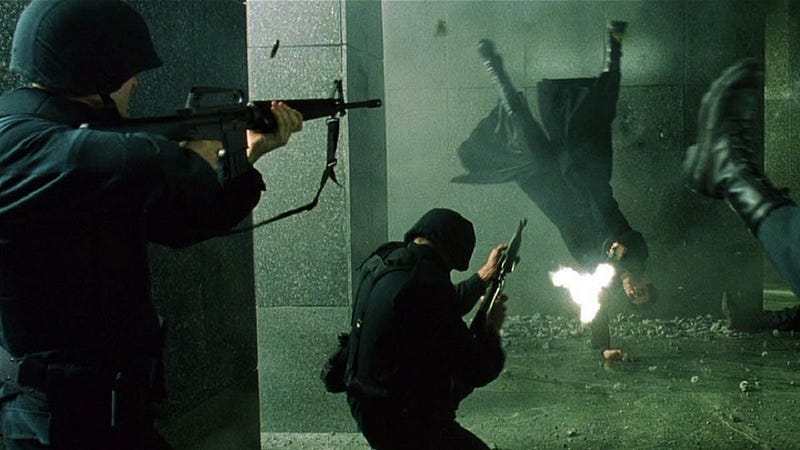
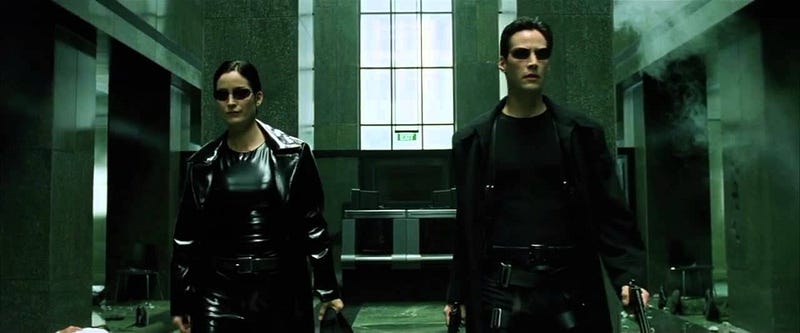
The arrival of the said back up guards also heralds the arrival of a change in music, as the haunting, melancholic beat is replaced with a thumping, iconic Matrix up tempo score. It also heralds the arrival of more astonishing bullet time and slow motion captured action, with Trinity again running up walls and both her and Neo performing gymnastic handstands through a hail of bullets all whilst shooting themselves and all captured brilliantly by The Wachowski’s. Heavily outnumbered, the multiple camera use, plus slow motion and bullet time angles display the graphic carnage as Neo and Trinity defeat their adversaries amidst a constant hail of bullets and crumbling brickwork all around them. Whilst only a short scene, this is the archetypal Matrix scene from the original film, of bullet time, slow motion captured action, a fantasy world mixed with reality and of performing feats simply unheralded before. The climax of the scene perfectly encapsulates this as, with the majority of the back up guards now dead, one remains until with a bullet time captured Kung Fu high kick, Neo eliminates him and re-joins Trinity to search for Morpheus.
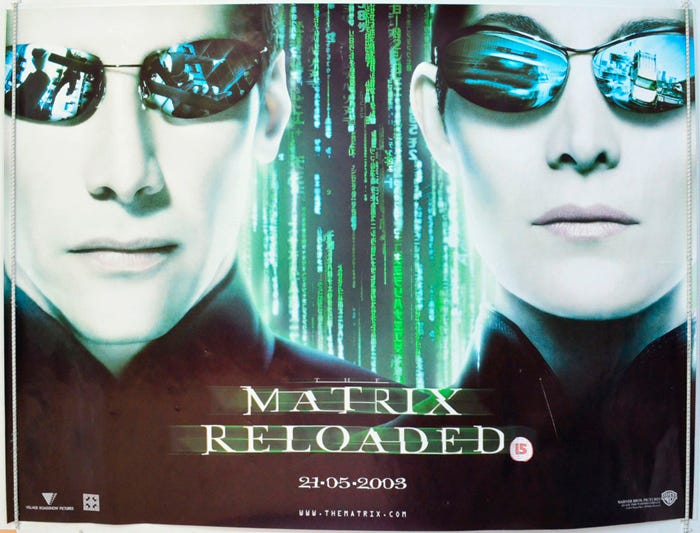
“But we well know that the reason most of us are here, is because of our affinity with disobedience”.
The first of the three key scenes dissected in this, the second of The Matrix trilogy of films contains everything both good and bad within the trilogy itself. As you will see, bullet time cameras depict two brilliantly choreographed fight scenes, the exposition of the story is heavy with confusing dialogue, but first, it’s key to note the overt religious iconography as Neo is transported back into The Matrix to meet with “The Oracle”.
Walking through a busy suburban street, it’s interesting to note the use of this religious iconography as soon as Neo re-enters The Matrix, from the pictures of Jesus, God and Buddha’s on a market stall table through to Neo’s Matrix breakdown of “Seraph” (Collin Chou) and his first meeting with this, the highest of Angels and protector of The Oracle. Introducing himself to Neo, he then calmly announces “first I must apologise” as he launches an attack on Neo and a brilliantly choreographed Kung Fu fight ensues, combining the three staple camera angles and techniques notably used by The Wachowski’s in these scenes, bullet time, slow motion and overhead shots, all of which produce a stunning, quickly edited, Kung Fu fight. No weapons are used but it’s clearly evident this isn’t a fight for Neo whereby he’s defending his life, moreover this is a test of wills, experience and of his determination to prove he is indeed “The One”. Seraph concludes the fight stating “The Oracle has many enemies. I had to be sure”, sadly the scene doesn’t end there as it would’ve been a complete and perfect scene, but the scene is set, if you will, for this and the following film as Neo states a lame gag as the scene itself sadly peters out.
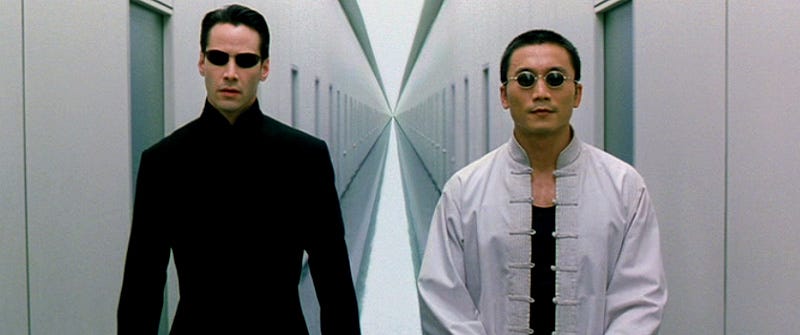
Following a brief exposition segment whereby Seraph confirms his purpose within The Matrix, we meet “The Oracle”. However, it’s interesting to note that within a few short segments of a scene and only a few brief minutes of screen time we as an audience have passed through a busy market area, bustling with people, to an eerily quiet room with just Seraph, now through another quiet, surreal looking, glistening white corridor and now through a door into the “outside” of a quiet park and our first meeting with “The Oracle”. Throughout The Matrix, this change of settings in quickly edited bursts of exposition is key, always unsettling you as to where you are, even why you’re here, and for what purpose? Is this still The Matrix? Is this another part of the construct or in fact a return to Neo’s older, “real life” life?
“The Oracle” (Gloria Foster) is a Matriarchal figure who’s character blossoms within the Trilogy. Here, and in the original, played by Foster, who exudes a calm exterior, a grand mother warmth and smile and self assuredness similar to Morpheus. The joint scene here is simple, all overlooked by her guardian, Seraph.

With a minimum of camera angles, this exposition heavy scene is both awkward in a clunky dialogue sense for the film (not the trilogy’s high point) but also awkward in terms of Neo’s understanding of why he’s here and for what purpose. Nervous and unsettled, Neo struggles with the concepts provided to him from an ever smiling and happy Oracle. Knowing Neo’s thoughts even before he knows them himself, The Oracle dominates the brief scene, which encapsulates her purpose, her programming, of a hacking within The Matrix itself and of a defining moment for Neo. He is indeed “The One” and although currently unaware of the significance of this, the fate of many lives rest on his shoulders. It’s also key to note that, as The Oracle explains far more eloquently than I could, Neo has made his choice, he now has to understand why, and to what ends. As demonstrated below:
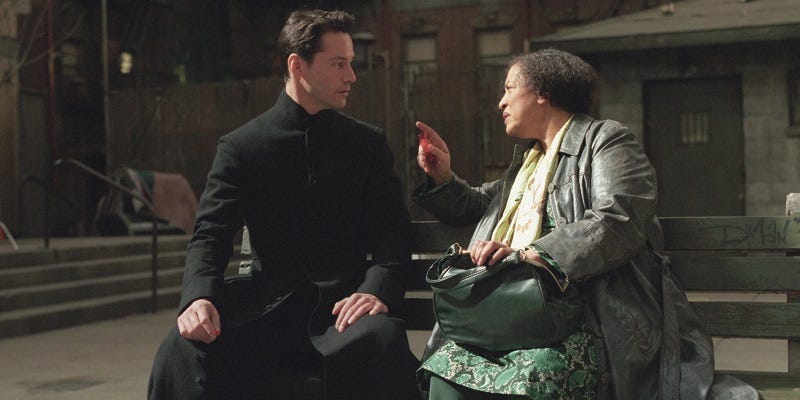
There follows the second of the fight scenes within this small segment of the film, commencing with the iconic shot of “Agent Smith” (Hugo Weaving) entering the courtyard through a flock of blackbirds and yet another meeting with his nemesis, Neo. The hack as described by The Oracle is aptly demonstrated by Agent Smith who, after a telling verbal joust and exchange with Neo “I killed you Mr Anderson. I watched you die. With a certain satisfaction I might add” regenerates and multiplies from all angles, numerous identical Agent Smith’s all surround Neo, the hack it seems has given Agent Smith the ability to assimilate with his enemies, now free to attack Neo and his team on their terms within The Matrix.
The fight scene that ensues is equal parts brilliant and absurd. The masterly camera angles and use of bullet time, slow motion and overhead cameras from the Directors is magnificent here, moreover the “inside” camera angles are more impressive, we as the audience are right in the middle of a chaotic battle with Neo far outnumbered by a constantly increasing number of Agent Smith’s joining the fray. It’s masterful yet a little absurd (even for this Trilogy!) as Neo fights off a hundred or more Agent Smith’s single handed before a (now trademark) Superman style leap to safety and a return to the mother ship. There are fleeting cuts to the ship before and during the chaotic battle, focussing on a worried Trinity and Morpheus, however it’s Hugo Weaving again who excels as the deliberate, pronounced talking Agent Smith, impeccably dressed and smug smile of satisfaction always present, pointedly referencing his control now, within The Matrix itself, and his destiny to destroy Neo once and for all.
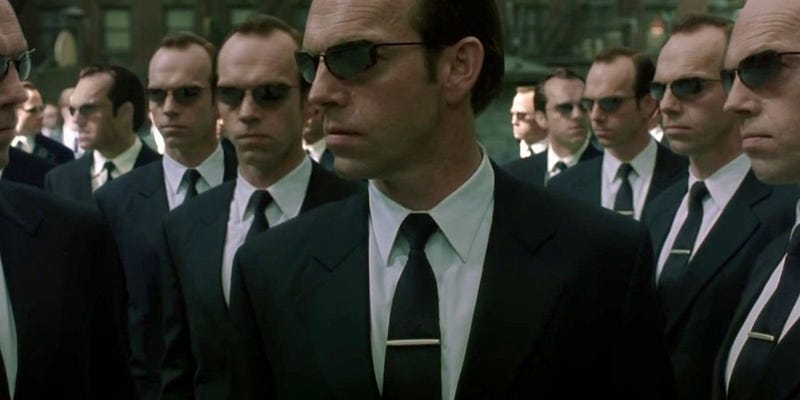
My second choice of key scenes both develops (or purposefully confuses) our understanding and perceptions of what The Matrix is. It is a short scene compared to the above and indeed my third and final choice below, is heavy on exposition, includes some poor acting but is redeemed by a sublime virtuoso performance from Lambert Wilson as “Merovingian”.
The Merovingian or self proclaimed “trafficker of information” holds court surrounded on one side by his beautiful wife “Persephone” (Monica Bellucci) and his bodyguards “Twin Number 1” (Neil Rayment) and “Twin Number 2” (Adrian Rayment). A true virtuoso performance from Lambert Wilson as yet another Matrix character oozing self assuredness, a calm exterior and seeming inner peace with himself, his position and indeed even his rank within The Matrix itself. With a deeply pronounced and methodical style of speaking and similar linguistic manner of an Agent Smith, the Merovingian takes centre stage, especially when The Wachowski’s adopt a simple, close in camera angle. Here, Wilson is superb and dominates proceedings with a sublime matter of fact air and although numerous other camera angles are used for a simple talking heads scene, this is the key angle. Morpheus, Trinity and Neo are resplendent in their iconic black dressed style of the original, however their performances are weak here and definitely overshadowed by The Merovingian. Their counter balance to The Merovingian’s air of certainty is used to good effect, thus highlighting his “might is right” and his assuredness that “causality” is the way of The Matrix.
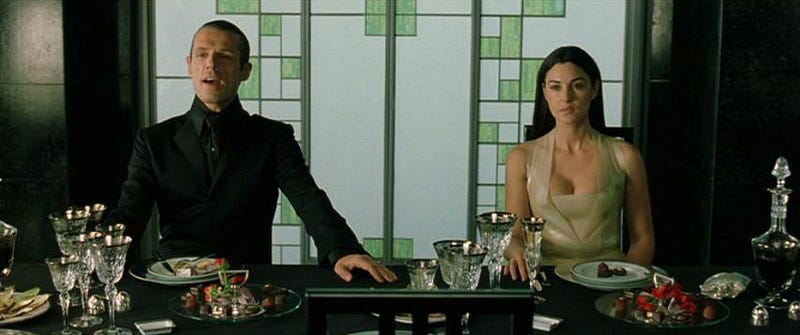
On Floor 101 of a high rise office complex, amidst a busy restaurant full of diners, the top table is assured for The Merovingian as he decrees again that causality, contrivances, language and time itself are for The Matrix. Not fate, choice or love, but causality and importantly, programming. The illusion of power and huge metaphors for the film(s) themselves are highlighted, of cause and effect, changes to systems and programs and, importantly again, the ability within The Matrix to alter perceptions. A veiled threat to Neo, he counters personal choice with altered perceptions, choice and free will with “causality” (again), ending the scene brilliantly with a program he wrote specifically for The Matrix.
Demonstrating a Matrix computer code or “program” in the form of a chocolate desert he’s written, The Merovingian delights in playing to his audience as he teases yet subjects a “bourgeois and boring” female to an orgasm! Brilliantly shot by The Wachowski’s, mixing simple close ups of The Merovingian deeply enjoying the sensation and torment this brings the unnamed female diner with the diner herself and the important green computer code of The Matrix itself, it’s a superb short segment of an otherwise brilliant exposition scene.
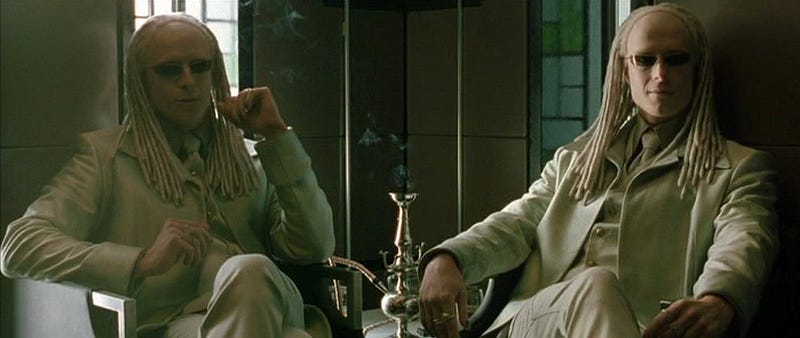
The third key scene dissected here has virtually everything that is brilliant from the trilogy of films as a whole, plus a clunking, ludicrous ending to the scene which I won’t divulge! Apart from that, it has everything, numerous uses of the bullet time cameras, immense slow motion captured action, combat and fighting, characters “morphing” between vehicles/into vehicles/out of vehicles during numerous breathless chase sequences and some of the very best camera work (edited brilliantly) seen on a cinematic big screen.
Escaping with “The Key Maker” (Randall Duk Kim), Morpheus and Trinity are seeking an exit from The Matrix and are being remotely guided by “Link” (Harold Perrineau), an Operator outside The Matrix watching the action unfold through the green matrix computer code on board the mother ship. His job is simple: follow Morpheus’ orders, secure an exit and guide them there. For maybe the first time in this film, the Operator’s guidance role is fully utilised as we cut back and forth from Link’s instructions, worries and fascination for the unfolding drama as he watches the scrolling green screen of code.
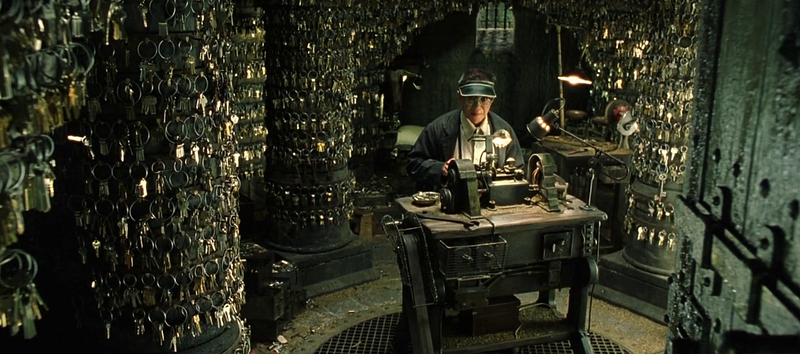
Sensing his friends are in desperate trouble and taking a call from “Niobe” (Jada Pinkett Smith) he sends her the co-ordinates. Meanwhile, utilising every trick in their camera book, The Wachowski’s propel the first of the chase sequences along breathlessly, as the bullet riddled car containing Morpheus, Trinity and The Key Maker is being chased both by Agents, the Merovingian’s guards (Twin Number 1 and Twin Number 2) and numerous police cars. The action never ceases as with every tumbling, crashing car on the freeway the frenetic action is cut to another piece of drama, one of the Twin guards morphing into our hero’s vehicle to kill the Key Maker and holding a hand to hand Kung Fu combat battle with Morpheus, Agents morphing into passing trucks to continue the chase and other Agents leaping (bullet camera captured) from one vehicle to another in pursuit.
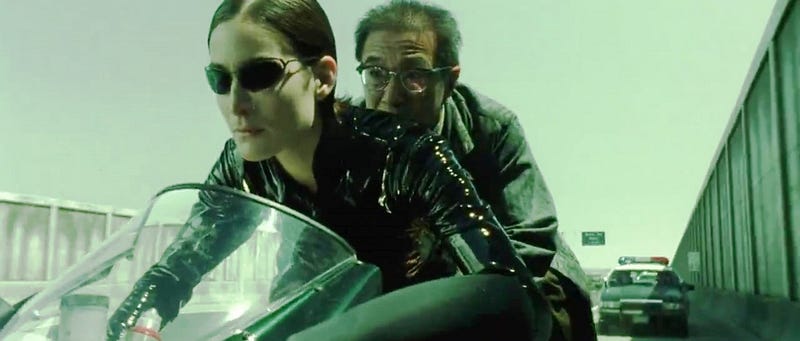
The mid way point of the chase, with Trinity and The Key Maker making their escape now on a motorcycle, Morpheus stays behind to brilliantly defeat the pursuing Twins (note the Samurai Sword — that will become more evident later in the scene!) and the chase resumes, with Trinity and The Key Maker on the motor cycle and two Agents in hot pursuit. What follows is another breathless chase sequence, the Key Maker’s escape back to Morpheus and a rolling, brilliantly captured in every sense fight scene between Morpheus and an Agent atop a moving trailer truck. Again, the camera work and capture of the scene is magnificent as a desperate fight ensues, a Kung Fu battle with swords and knives on a moving trailer that has everything as the scene reaches it’s dramatic climax. Morpheus’ leap (similar to The Agents themselves) from a moving car to the top of the moving trailer is a joy, captured in bullet camera “time” it perfectly encapsulates both the tremendous vigour of this scene, a motif for the film and a brilliant showcase for The Wachowski’s and the advances they pioneered throughout the trilogy.
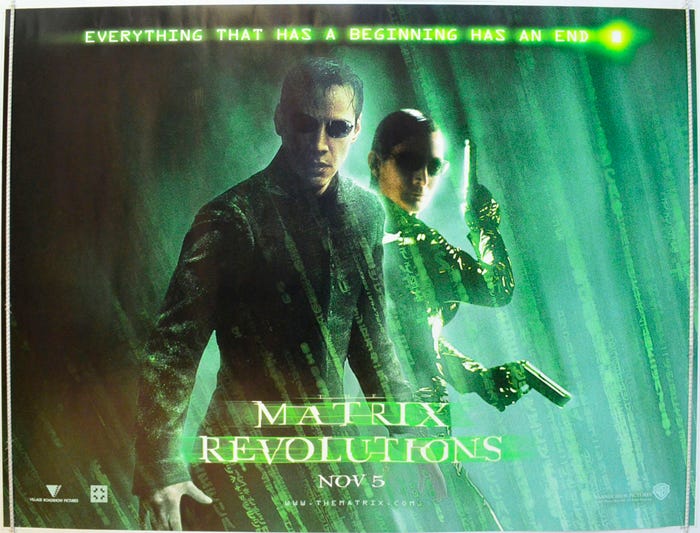
“Mr Anderson. Welcome back. We missed you”.
In this, the final instalment of the trilogy, three very different scenes are dissected, each giving a slightly different slant to the story, and first we start with Seraph, Trinity and Morpheus trying to break into a nightclub for yet another showdown meeting with the Merovingian:
Eerily reminiscent of the original film’s iconic shoot out scene in the foyer of an apartment building, here the action takes place first in a basement whereby four guards are quickly dispatched. One of the guards challenges Seraph with gaining entry “only way you’re getting through this door is over my big, dead ass” and very quickly, and with clever cuts between the four individual demises, that prophecy has indeed come true (in joke there for Matrix fans). Taking the elevator to their destination and a nightclub housing their target, the Merovingian, Seraph confirms to his friends that either they’ll meet a simple coat checking woman or “many men”. As the shoot out that ensues exemplifies, they do indeed tackle many men. The action is immediately shot in bullet time captured motion, amidst the crumbling debris and bullet ridden entrance similar to the original’s iconic scene, however the twist here are the Guards who immediately reside on the ceiling.
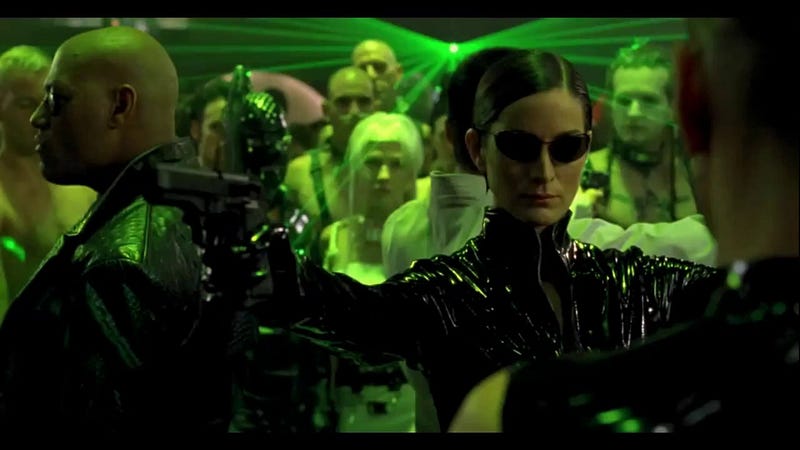
Amid the hail of bullets, slow motion and bullet time captured camera angles, Seraph, Morpheus and Trinity hunt down the guards one by one, gymnastic, running up walls, leaping in slow motion, all brilliantly edited and shot. One camera angle in particular is evident, jarring but adds to the scene brilliantly, that of an upside down angle. Every other Wachowski technique is used, but the use here of that particular angle, although not unique, certainly adds to the flavour already provided by the bullet time/slow motion cameras. Two key issues are striking from this brief but excellent scene. Firstly the finale’. Trinity, getting the better of her exchanges with her assailant is shocked when he elevates from the floor to the ceiling in an apparent attempt to escape. Trinity’s brief look of admiration is key, before she too elevates herself and dispatches him through a wall, with a flying Kung Fu style kick. More importantly though is the second key, and that of the dark green tinge to the scene. When used, it’s very evident that we are in The Matrix, of the green computer coded reality, and it’s brilliantly used again here.
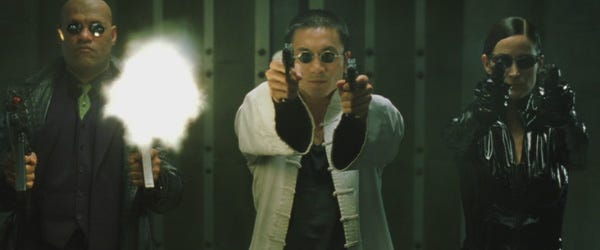
The second dissected scene is a very short but equally very key scene in Neo’s Quarters aboard the ship after announcing to the crew that he has to “go to the Machine City”. Not because of providence or orders or even advice from The Oracle, but a gut instinct and by following his heart, he knows instinctively where he must go and how he can best help his crew and the city of Zion.
One of the rare overt sweet and tender scenes within the trilogy, Trinity visits Neo in his Quarters both as support and to confirm she’s coming with him. Neo, stumbling over his words as he tries to outline his reasoning for having to go is tenderly cut short by Trinity and before they kiss and embrace to end the scene, Trinity shows her unbounded love for Neo:
“I knew it the moment you said you had to leave. I could see it in your face. Just like you knew the moment you looked at me…..that I was coming with you”.

“Six hours ago, I told the Merovingian I was ready to give anything and everything for you. Do you know what’s changed in the last six hours?. Nothing”.
The third and final dissected scene is the final climatic battle scene with Agent Smith, but being the great Editor that I am, I’ve edited the ending. That would be a spoiler too many. However, with a heavy green tinge again particularly evident, amidst pouring rain, thunder and lightening and surrounded by hundreds of onlooking Agent Smith’s, Neo calmly and slowly walks before them until one Agent Smith breaks from the pack to stand before and confront him.
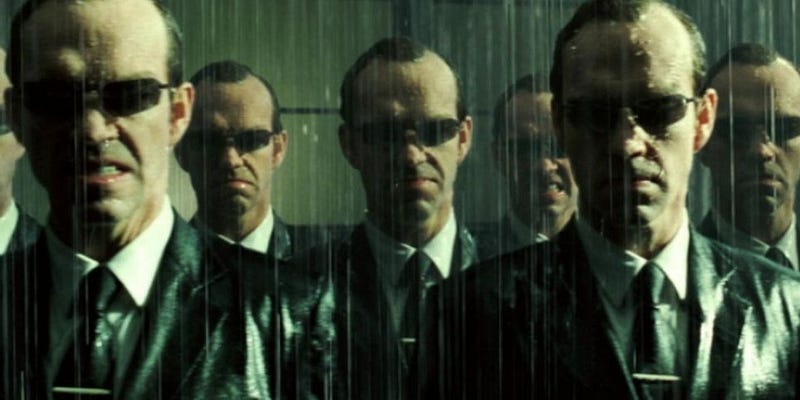
Agent Smith: “Mr Anderson. Welcome back. We’ve missed you. You like what I’ve done with the place?”
Neo: “It ends tonight”.

Agent Smith: “I know it does. I’ve seen it. That’s why the rest of me is just to going to enjoy the show because we already know that I’m the one that beats you”
Neo, in trademark long black trench coat and sunglasses. Agent Smith similarly in trademark black suit, tie and sunglasses approach each other via slow motion cameras, amidst again the thunder and lightening, the pouring rain, the heavy green tinge of The Matrix and the signature tune of The Matrix itself, the long twisting metallic effect, sound effect. All trademarks themselves by now. Also added to the mix and tension now is a fantastic, doom laden orchestral score from Don Davis (whose music within the trilogy is often cruelly overlooked) and a swift cut ensues to a sublime overhead shot of the protagonists as they engage in the first of a series of frenetic Kung Fu style combat duels.
I will add no more but suffice to say the trilogy, though weak in it’s final chapter is an astonishing overall project from The Wachowski’s. Ground breaking, revolutionising cinema, challenging audiences, an inspiration even to future film makers. A monumental achievement. If only they’d toned down the CGI in the last instalment.
Alas!
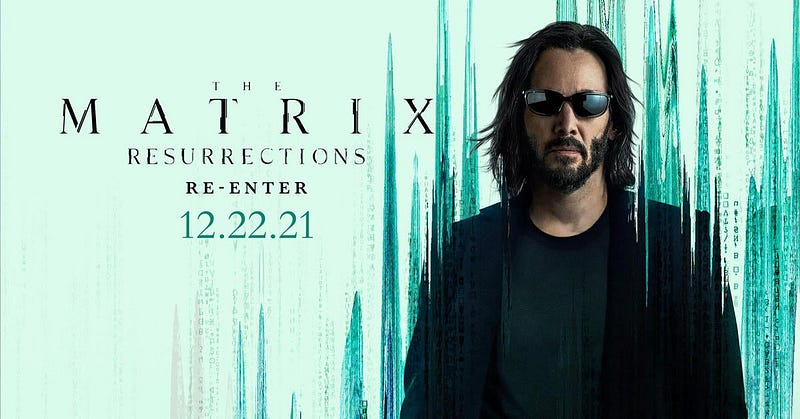
“No Lieutenant. Your men are already dead”.
It was the 23rd December but it’s now the early hours of the following day, Christmas Eve, and rather pleasingly, despite the early hour, another day within The Matrix. I have just watched the latest and long awaited new instalment within a series of films that I obsess over and adore and if I have one criticism of the follow up films to the original in 1999 was that they were too laden down with CGI effects. That criticism cannot be levelled at this film, and that’s in a very good way and a high compliment for a film that I liked immediately (I smiled A LOT throughout) and one that I know in my heart I’m going to grow to absolutely love. Less overbearing CGI, more Matrix tales weaved and crucially, the love story that pervades and saturates this series of films is all present, correct, alive, well and perhaps even as per the titular nature of the film itself: resurrected.
As I hope I’ve conveyed in the above reviews, and aside from the esoteric spells these films seemed to cast over me, the central theme is just a good old fashioned time twisting and reality considering love story. That was splashed on the screen in spades as “Neo” (Keanu Reeves) and “Trinity” (Carrie-Anne Moss) first glanced at each other in a seemingly familiar and perfectly normal, real life coffee shop and that was one of the many early scenes that made me smile broadly and instantly warm to the film. It was clearly evident that this was still, at it’s spirit and existential heart too, a love story, and indeed a human story, and the continued scenes away from the blur of the CGI were magnificent. “Niobe” (Jada Pinkett Smith) embodies this humanity brilliantly as she addresses her guard of troops and reprises her role from previous films with another of the film’s beating hearts. As does newcomer “Bugs” (Jessica Henwick), captain of the mother ship and immediately propelled into a film that is so much richer for her constant screen time. Yahya Abdul-Mateen too infuses the returning “Morpheus” character with the same charm that pervaded Laurence Fishburne’s portrayal in the original trilogy and to keep spoilers or hints to a bare minimum, the remainder of the predominant roles are brilliantly filled by Jonathan Groff as “Smith”, a returning Lambert Wilson reprising his role again as “The Merovingian” and of particular note, and which will be expanded upon later is Neil Patrick Harris’ pleasing portrayal of “The Analyst”.
If you’ve read this far and/or are a fan of this series of films and you haven’t seen this yet, then these next few essential sentences here will hopefully whet your Matrix appetite as, from the opening shot through to the end of the first ten or so minutes we are very definitely back in The Matrix, and bathed in it’s beautiful decades long iconography. From it’s signature time twisting evoking theme tune, through to a telephone dial tone, the distant voice of a Matrix Operator and the iconic green “Digital Rain” of the tumbling number sequences of the electronic and digital Matrix, we are very definitely back within the construct and a construct that at first looks eerily reminiscent of the first film of the original trilogy as it’s been re-made almost shot for shot within the opening minutes of the film. But whereas it was merely policemen and their torchlights in the original, now it’s heavily armed Robocop type enforcers with the torchlights in a dark corridor, approaching and kicking down a residential door, and there, in all her Matrix (and black PVC) glory is “Trinity”.
Or is it?
Or indeed is it a Matrix within a Matrix? Possibly Deja Vu? There’s very definitely a black cat and with more than a nod to the original film our cinematic kitty is now called “Deja Vu”, but is this too a glitch within the Matrix? There appears to be some kind of portal or loop now and whereas the Matrix itself appeared originally as a singular manifestation, now there are two? More? These are all philosophical and perhaps metaphorical questions but what isn’t in question is that as soon as you as the audience drop your red pill you’re back in the Matrix, and a juxtaposed simulation that is both heavily familiar and indeed slightly discombobulating as you piece the early narrative together. But what is evident immediately is the love that seeps into every frame of this film and it’s constant references to the original 1999 film on which this relies so heavily (the two follow up films are acknowledged but it’s predominantly reflected back to the original) and whilst some of the faces may have changed, do change and there’s Deja Vu all around, this is firmly a Matrix film and all of the associated metaphysical, psychological, pharmacological and pseudo Religious and Spiritual touchstones are rooted very firmly in place.
“Welcome back, to the real world” — Well quite! Rather than regurgitate a lot of my writing and adoration for these films from my writings on the original trilogy, I’ll refer you instead to the above for this review alone and assure you that this is simply everything (more or less) that a fan of the series would love to see here in the 2021 instalment. It’s simply a Matrix film! But also created by the same visionary and naturally held close to their heart. Yes the fight sequences are stellar. Again. Yes there’s ample use of “bullet time” and yes we have the ultimate Hero/Villain or Good versus Evil battle. You can still drop the red pill and venture to Wonderland or you can stick with the blue version and the dystopian reality envisaged by “The Architect”. I have gripes and could be cynical (Face Masks on the train but none for our otherworldly heroes and villains and a “Quarantine” prison cell to combat the “Risk of Infection”?). Please.
But rather than these cynical yet well placed gripes, let’s focus on the triad, the triangle, the trio or perhaps even the trinity of stars whose presence here lit up a long awaited venture back into the real world.

“Neo” (Keanu Reeves). Also known as “Mr Anderson” or “Thomas Anderson” and particularly here in this instalment simply as “Tom” to perhaps humanise our hero, and a superhero we first see atop a skyscraper building, standing alone, long haired and a juxtaposed Superman/Christ figure and similarly as well as religiously, resurrected. Neo may be the red pilled saviour but in a blue pilled world of conformity he is a recovering suicide survivor as well as recovering from a mental breakdown. Splinters of a recovering mind perhaps or yet more glitches in the Matrix pervade his thinking and thought processes he tries to recover from, make sense of and even occasionally see the funnier side of in league with work colleague “Smith” (Jonathan Groff) and particularly his therapist or “The Analyst” (Neil Patrick Harris).
Tom, in whatever constitutes “the real world” is a highly successful coder and creator of The Matrix as a series of games but as soon as a sequel is required his mind begins to splinter and fracture again as he reimagines yet another dive into The Matrix. Now he is surrounded by focus groups droning endlessly on as to what makes The Matrix so compelling and it’s original creator begins to wonder yet again what is real, what is imagined, is this creation his or from another architect? And why am I surrounded by bloody focus groups!
Reeves as the film’s Christ like saviour is sublime once again and as well as excelling in the film’s vast action sequences he really excels in the one on one scenarios that pervade the film as well as his long yearned for love for Trinity. This was so brilliantly demonstrated in their coffee shop scene as he fondly announces and directly to an enchanted Trinity “This is the best thing I’ve done in a long time”.
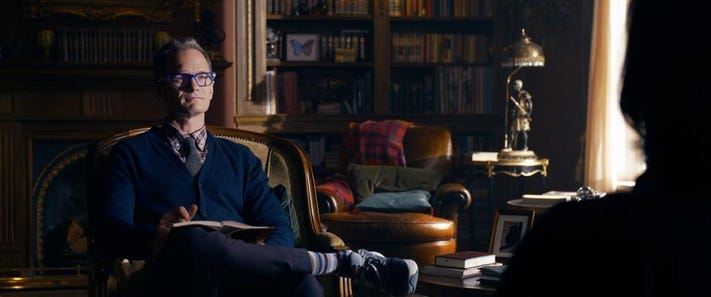
“The Analyst” (Neil Patrick Harris). Ostensibly in between our yearning lovers is yet another sublime performance from an always impressive Neil Patrick Harris. Whereas in previous films we’ve had an “Architect” now we have an “Analyst” and whilst a therapist cajoling Tom back to reality and back from the brink, Harris infuses his character with real personality, zest, charisma and a real twinkle in those bespectacled eyes. Far more than a therapist or analyst, Harris’ performance is as central as any here and just as wonderful as his co-stars.
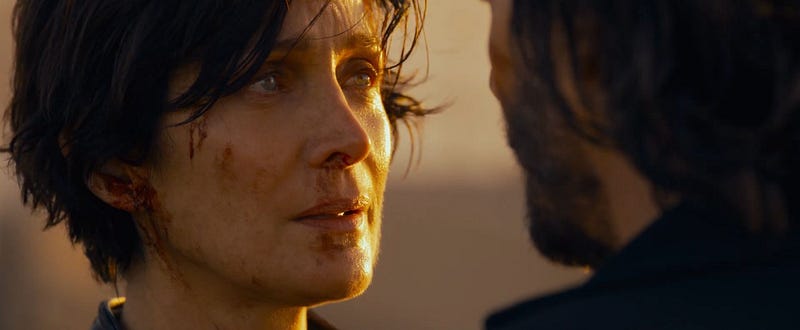
“Trinity” (Carrie-Anne Moss). In her blue pilled life of wife, mother of two and rider of motorcycles, Trinity or rather “Tiffany” in this world is a busy, smiling, self effacing and warm human being. But there’s something there, a nagging doubt, a splinter, a fraction of a memory, a longing desire that brilliantly encapsulates Moss’ performance. Again. The picture above is from the trailer but the coffee shop scene(s) are crucial for her development (in more ways than one) and the intimate shared scene with Tom is a real joy that, crucially, and as with so much else in this film, just made me smile and smile very broadly indeed.
“I never believed I was The One. But she did. She believed in me. It’s my turn to believe in her”.
So Says Neo as we approach the film’s denouement and sadly spoilers prevent me from really elucidating on what I take from both this small quotation, the trilogy that came before and indeed this fourth instalment as a whole. The quotation leaves an opening for all and an opening for all interpretations but rather than spoil or hint further, yes I was righteously cynical at the “Quarantine” and yes, depending on your point of view, the film was rather too fond of it’s original 1999 inspiration and we could definitely have done without the phony focus groups. It could be argued that this fourth and latest instalment of The Matrix (the ending hints at more to come) is too reverential of itself at times but the obsessive in me loved that and indeed loved the continuing through line of the film and the series as a whole. That of the belief in love, human love, connection, desire, warmth, humanity and a oneness of love that even the most cynical amongst us still crave.
Drop a red pill. Ignore what Neil Patrick Harris has to say! And take flight again with Neo and Trinity. It’s a love story with a mind bending twist.
But it’s still an unequivocal love story and quite brilliantly told.



